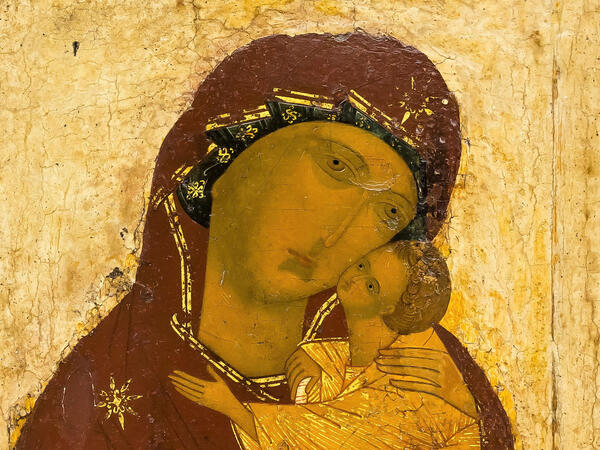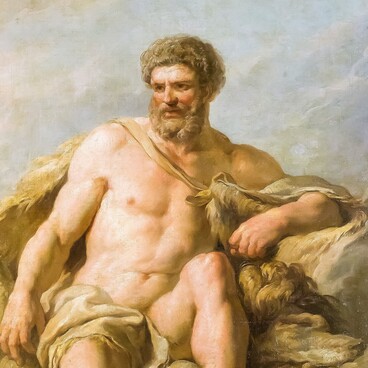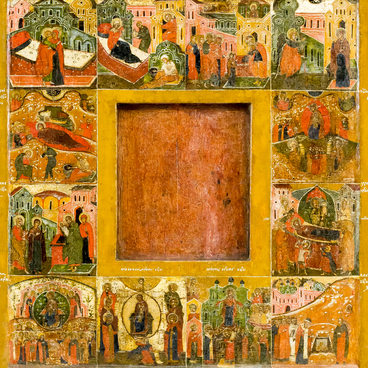The icon ‘The Virgin of Tenderness’ was created by an unknown painter at the turn of the 16th century. This is one of the oldest icons in the museum collection.
The name ‘Eleusa’, which means ‘tenderness’, refers to a whole distinct type of iconography. Its characteristic feature is the depiction of the Infant Jesus Christ nestled gently against the Virgin Mary’s cheek. Such closeness symbolizes Mary’s endless love and her great sorrow for the future sufferings of her Son. This type of iconography was already known in the early Christian art of Byzantium, but its final form would be established only by the 11th century. In Russian culture, the ‘Eleusa’ type has become one of the most adored ones — the Virgin Mary embracing the Child is captured on the famous ‘Vladimir Icon of the Mother of God’.
Icons of the ‘Eleusa’ type may significantly differ from each other. The icon from the museum collection is one of the rare versions. It is unique because of the unusual gestures of the Infant Jesus: He embraces the Mother of God with his left hand, while pressing a rolled scroll to the chest with his right one. The position of the Virgin Mary’s hands is different from many other ancient iconographic versions.
The preserved original image of the faces of the Mother of God and the Child is yet another characteristic feature of the icon. This detail is particularly important, for when the colors darkened from old age, the ancient icons were not restored, but “repainted”, so that a new image would appear on them. The painter, who did the work on “The Virgin of Tenderness”, renewed the clothes and background, but decided to leave the faces untouched, which might mean that the image was revered as special and miraculous. Due to that decision, the original elements of the icon from the 16th century have been preserved to this day.
Researchers noted that it took great skill to depict the faces — they are rendered by the thinnest translucent layers of paint going from dark to light shades. It is also worth mentioning that the artist possessed the impeccable technique of icon painting and managed to reflect the emotional state of the Mother of God. All this makes “The Virgin of Tenderness” one of the most outstanding works of Old Russian art.
Until the 1920s, the icon was in the prayer house of the Pomor Church of Kazan, then it was transferred to the State Museum of the Tatar ASSR. In 1962, it entered the State Museum of Fine Arts of Tatarstan Republic.
The name ‘Eleusa’, which means ‘tenderness’, refers to a whole distinct type of iconography. Its characteristic feature is the depiction of the Infant Jesus Christ nestled gently against the Virgin Mary’s cheek. Such closeness symbolizes Mary’s endless love and her great sorrow for the future sufferings of her Son. This type of iconography was already known in the early Christian art of Byzantium, but its final form would be established only by the 11th century. In Russian culture, the ‘Eleusa’ type has become one of the most adored ones — the Virgin Mary embracing the Child is captured on the famous ‘Vladimir Icon of the Mother of God’.
Icons of the ‘Eleusa’ type may significantly differ from each other. The icon from the museum collection is one of the rare versions. It is unique because of the unusual gestures of the Infant Jesus: He embraces the Mother of God with his left hand, while pressing a rolled scroll to the chest with his right one. The position of the Virgin Mary’s hands is different from many other ancient iconographic versions.
The preserved original image of the faces of the Mother of God and the Child is yet another characteristic feature of the icon. This detail is particularly important, for when the colors darkened from old age, the ancient icons were not restored, but “repainted”, so that a new image would appear on them. The painter, who did the work on “The Virgin of Tenderness”, renewed the clothes and background, but decided to leave the faces untouched, which might mean that the image was revered as special and miraculous. Due to that decision, the original elements of the icon from the 16th century have been preserved to this day.
Researchers noted that it took great skill to depict the faces — they are rendered by the thinnest translucent layers of paint going from dark to light shades. It is also worth mentioning that the artist possessed the impeccable technique of icon painting and managed to reflect the emotional state of the Mother of God. All this makes “The Virgin of Tenderness” one of the most outstanding works of Old Russian art.
Until the 1920s, the icon was in the prayer house of the Pomor Church of Kazan, then it was transferred to the State Museum of the Tatar ASSR. In 1962, it entered the State Museum of Fine Arts of Tatarstan Republic.



